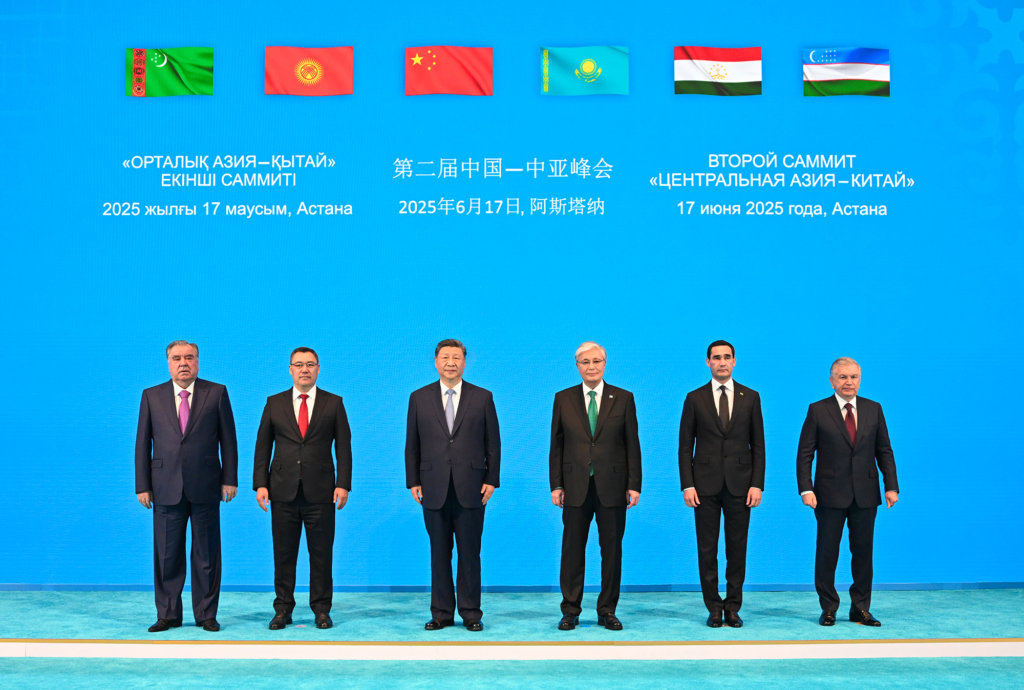
- The summit comes at a time when the Russian influence is slowly dying down post-Ukraine, and there is limited Western presence at the time.
- China has proposed to build railways, highways, and logistical hubs throughout the region.
- China’s role is seen shifting from a neighbour of the Central Asian countries to an economic partner and a regional architect.
The second edition of the China-Central Asia Summit is being held in Astana, the capital city of Kazakhstan, from 16 to 18 June 2025. Xi Jinping, President of China, personally attended the summit, which is a clear signal of how strategically important it is for China. The summit comes at a time when the Russian influence is slowly dying down post-Ukraine, and there is limited Western presence at the time. Central Asia is a region rich in energy, crucial minerals, and connectivity. China has a rich dominance in the region, through the Belt and Road Initiative (BRI) and immense trade in the region, but it aims to go beyond that, and dive into the security, diplomacy, and development sectors.
Although Central Asia is a landlocked region, it is rich in natural gas, oil, and minerals. Due to its location, it becomes strategically important due to its proximity to Russia, China, and the West. Earlier, Russia had a stronghold in this region, due to its history and proximity, but ever since the war with Ukraine, it has become weak in its regional grip. Moreover, the exit of the U.S. and NATO has also left a strategic void in the region since 2021. For China, this becomes the perfect opportunity to increase its influence in the region. It has an opportunity to fill the gaps with infrastructure projects, loans, and strategic engagement.
China has offered cooperation in multiple sectors. The first and most important being infrastructure and connectivity. China has proposed to build railways, highways, and logistical hubs throughout the region. The foremost focus will be on completing the pending project of the China–Kyrgyzstan–Uzbekistan railway. Then, China has also proposed to enhance regional trade zones and customs facilitation, and new bilateral trade agreements to reduce reliance on the West. Shared concerns and cooperation over counterterrorism, border digitisation, and intelligence sharing were also done. Talks on promoting soft and cultural diplomacy were also held, where the focus was on expanding student exchange programs and language institutions within the region.
This poses a direct threat to the strategic power that Russia used to hold in this region. To regain prominence in the region, Russia may push back, rather subtly, by using its military presence via the Collective Security Treaty Organization (CSTO). The United States and the European Union rely only on soft power and democracy aid, with very minor direct presence in the region. They struggle to match China’s rapid infrastructure diplomacy. In recent years, India’s interest in this region has been growing, which it has been channelling through its “Connect Central Asia” policy, whose focus areas are: strengthen political, economic, military, and cultural ties with nations in Central Asia. Moreover, India has been portraying its capabilities and interest in the region through Chabahar Port and the International North-South Transport Corridor (INSTC). This further helps India to counter China’s BRI. Meanwhile, Central Asia nations aim to maintain a balancing strategy to avoid overdependence on any one country.
China’s role is seen shifting from a neighbour of the Central Asian countries to an economic partner and a regional architect. However, these nations have to be careful in the way they deal with China as a partner, maintain checks on debt dependency, and not become trapped in a situation similar to some South Asian countries.
References:
- https://www.aljazeera.com/news/2025/6/16/chinas-xi-jinping-meets-central-asian-leaders-why-their-summit-matters
- https://www.specialeurasia.com/2025/06/16/china-central-asia-summit/
- https://www.bloomberg.com/news/articles/2025-06-15/xi-takes-push-for-global-sway-to-central-asia-with-kazakh-visit
- https://thediplomat.com/2025/06/2nd-central-asia-china-summit-set-for-june-17
Archita Gaur is a postgraduate student at the School of International Studies, JNU. She specialises in the World Economy and has a strong interest in public policy, economic research, and governance. The views expressed are the author’s own.
